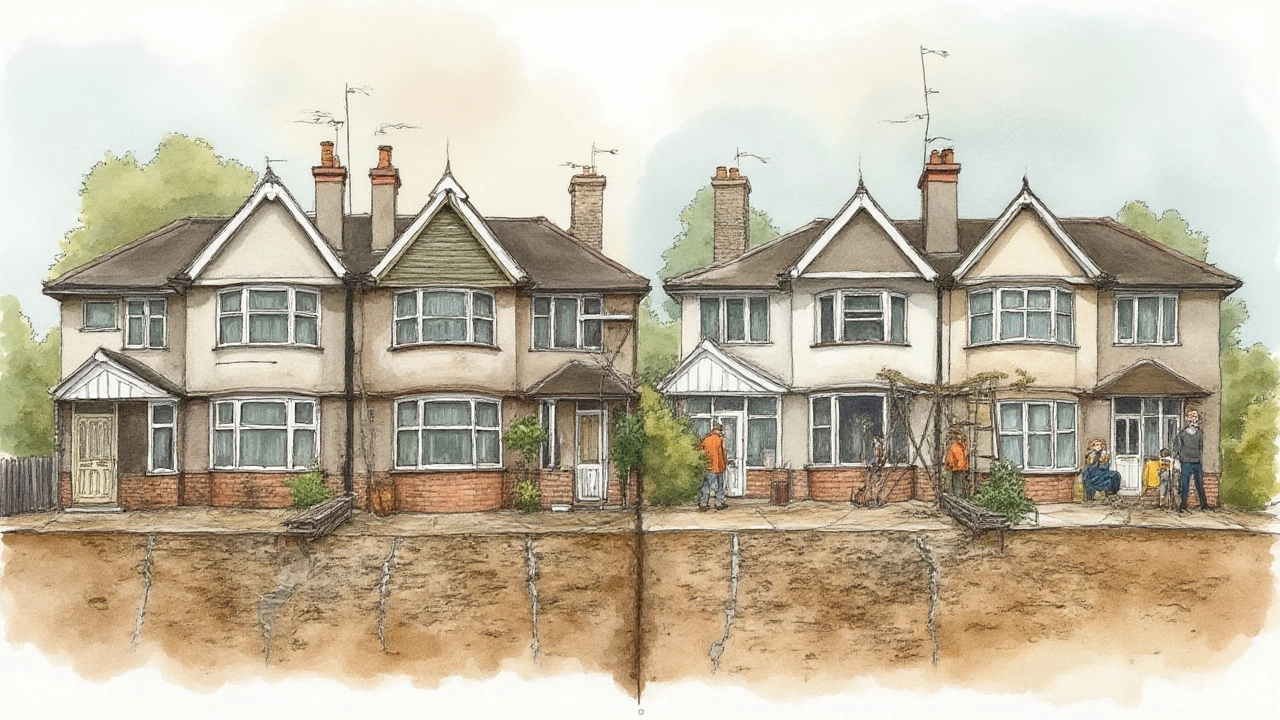Imagine spending thousands to fix a crack in your house, only to discover the repair made things worse. Sounds impossible, but it’s something homeowners actually face—not just horror stories on some TV programme. There’s this unnerving reality: foundation repair isn’t a surefire promise for peace of mind. If it goes wrong, it can lead to bigger cracks, stubborn doors, busted pipes, or even compromised structural safety. Some people think once you call in the pros, your house is back to perfect. But what goes on under your floorboards can be touchier than you’d expect.
Why Foundation Repair Can Backfire
Here’s something you probably didn’t want to hear: foundation repair, when mishandled, has been known to cause a chain reaction of new headaches. Quite a number of homes in Bristol and across the UK sit on tricky soils—clay especially—that swell and shrink depending on our famously fickle weather. That swelling and shrinking is what leads to foundation shifts in the first place. But fixing the problem? It takes more than just concrete and optimism.
So what actually goes wrong? Well, a good chunk of repairs involve lifting or leveling the house back to where it “should be.” If that’s done too quickly or unevenly, walls can crack, tiles may pop off, and pipes hidden below might suddenly snap. Imagine a building that’s been drooping for years—every part has subtly adapted to that slant. If you yank it straight overnight, it’s like forcing your bent arm out suddenly: something’s bound to give.
There’s a 2017 report from the Building Research Establishment, the folks who set the standards for this kind of stuff in the UK, warning about the risks. More than 25% of their case studies showed secondary damage after rushed or heavy-handed repairs. The most heartbreaking bit? Most of it was preventable with slower, carefully staged work.
On top of that, some so-called “repairs” focus on symptoms, not causes. Plugging visible cracks without addressing soil movement or poor drainage is a bit like painting over rusty metal—the rot keeps going, just out of sight. Improper repairs might even hide new cracks forming, giving homeowners a false sense of safety.
What’s less known is the risk of ‘over-correction.’ A typical example: underpinning piers are installed to stabilise a corner of a home, but the rest of the foundation remains unsupported. This can warp floors, twist door frames, and cause cosmetic and structural damage far from the original problem. It’s rarely as simple as fixing one spot—houses are unpredictable, almost living things.
Knowing When Foundation Repair Is Needed (and When It’s Not)
It’s tempting to jump at every crack and call for repairs, but not all foundation imperfections spell disaster. Homes naturally settle over time, especially older builds common in places like Bristol, Bath, or down in Somerset. Many classic Victorian terraces have hairline fracturing in the plaster that’s barely moved in 50 years.
Here’s the trick: not every sign of movement demands expensive work. Cracks smaller than a pencil lead, for instance, may just be cosmetic. If they’re not widening, or if doors and windows aren’t sticking, you can usually hold off. Knowing when to panic—now that’s the art.
How about checking your own home? Watch the pattern: vertical cracks are usually less worrisome than diagonal ones, which hint at shearing or uneven settlement. Multiple cracks in the same area, bouncing floors, or suddenly jammed interior doors? That’s time to seek advice. But before any builder rolls up, get a structural survey done. Most reputable repair firms in the UK will insist on a surveyor’s report before doing major foundation work. It’s protection for you and your wallet.
Another insider tip: be wary of sales-pitch solutions. If someone says, “We can fix this in a single day for a fixed price,” that’s a red flag. Every property is as unique as its owner (or, at least, as their pet’s odd habits). Repairs should be custom to the structure, soil, and the extent of movement. A thorough inspection and a clear explanation of risks are worth more than a fast fix.
Don’t forget neighbouring properties. In terrace rows, for instance, heavy-handed repairs can shift loads and affect next-door structures. There are even cases where underpinning caused issues two doors down the street—now that’s an awkward way to meet your neighbours.

Types of Foundation Repairs and Their Potential Pitfalls
Not all repairs are created equal. Depending on the trouble, you’ll run into different methods, each with its own set of risks if handled poorly. Let’s look at a few common options:
- Underpinning: This means adding new support underneath sinking parts of your house. Done right, it can save homes from collapse. But if only one section is underpinned and the soil acts up elsewhere, new cracks and unevenness may appear in places you least expect.
- Slab Jacking (or Mudjacking): Involves pumping a cement mix beneath a concrete slab to raise it. But if the lift isn’t even or the mix seeps into voids unpredictably, you can cause bulges and more uneven floors than before.
- Piling: Steel or concrete piles are driven deep to bedrock or stable soil. Piling can be incredibly effective, but if contractors don’t reach the right depth, your house settles again—sometimes even faster than before.
- Crack Stitching: This involves inserting rods or mesh into wall cracks to stabilise. It’s great for minor settlement, but doesn’t help if the movement is ongoing. In those cases, cracks will just reappear a few months later.
- Resin Injection: Expanding resins are used to fill weak soils or large cracks. The process sounds high-tech, but if the material is over-injected, walls can bulge or even crack open. And if injected too shallow, the support doesn’t reach where it’s needed.
The key factor across repairs is moisture control. Fixing the foundation without resolving drainage, downspout, or grading issues is asking for trouble. There are notable reports from Thames Water that show how burst pipes or faulty drainage often cause the majority of subsidence in Greater London houses—not just natural soils.
Old houses with shallow foundations (think early 20th-century terraces) can also suffer when modern renovations overload the structure. Putting in heavy kitchen extensions or fancy conservatories without reinforcing the old base is a recipe for trouble. Every change above must be matched with proper support below, or it’s open season for cracks and sloping floors. The best repair businesses always stress this kind of systemic thinking rather than piecemeal solutions.
How to Avoid Foundation Repair Nightmares
No one likes to think about worst-case scenarios, but skipping the scary details doesn’t make them less real. Want to avoid disaster? Start with small habits: keep gutters clear, channel rainwater away, maintain consistent moisture levels near your foundation, and don’t plant thirsty trees right up against the walls. Japanese maples might look great, but those roots go searching for water with remarkable determination—and they’ll pick your foundation over your neighbour’s patio every time.
Before you hire anyone, insist they explain their plan in plain language—not just a quote with technical mumbo-jumbo. Good contractors will walk you through step by step, describing exactly what they’ll do and in what order, along with all possible effects. Always check for relevant insurance (like the NHBC Buildmark warranty for post-1990 houses), and read up on independent third-party reviews. Don’t just trust testimonials on the company’s website—look for real names, real jobs, and clear before/after photos.
Get more than one opinion. Reputable contractors won’t be offended if you ask for a second or third estimate. Amateur “cowboy builders,” on the other hand, hate scrutiny. If someone pushes you for instant decisions or won’t detail the risks, walk away.
Consider ongoing monitoring before and after major repairs. Fixing cracks or leveling a slab is only the beginning. Many surveyors recommend periodic checks (at least annually) for movement, usually tracked with simple tell-tales—little gauges stuck across a crack. They’re cheap, reliable, and a world away from guesswork.
Finally, if you suspect a repair has gone wrong, act quickly. Don’t hesitate to contact a professional engineer or an independent surveyor. Well-documented complaints and evidence (before-and-after photos, invoices, written guarantees) give you leverage if things head for legal discussions.
Foundation repair isn’t evil, but it isn’t foolproof. It’s about careful planning, slow and steady action, and remembering that homes—like people—don’t always bounce back as easily as you’d hope. When in doubt, do more research and never rush the fix. Prevention wins every single time.





